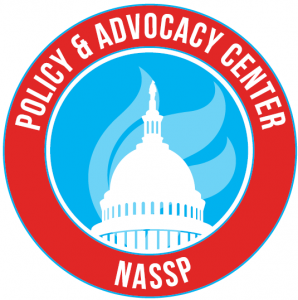
Learning occurs best in a warm, inviting, and orderly school setting, where students are safe and feel free from theft, threats, intimidation, bullying, weapons, drugs, or violence of any type.
Principals accept that their first responsibility is to foster such a climate, and the public continues to confirm that priority. NASSP believes that school leaders and staff members, along with community members and leaders, have a shared responsibility to ensure that schools are safe and orderly. All students have a right to attend schools without fear of violence, and Congress must help support a holistic approach to violence intervention and prevention both inside the walls of our schools and in our communities. Trusting relationships in school are the most effective means of ensuring school safety, much more so than metal detectors or firearms. NASSP strongly opposes any effort to arm teachers, principals, or other school leaders with the exception of specially trained school resource officers. Policymakers should focus their efforts on providing additional funding and support for mental health services, crisis identification programs, and on enhancing school safety procedures.
+
Legislative or Policy Priorities
- DREAM Act (S. 1615/H.R. 3440): Letter sent to Congress by 300+ child and youth advocates in support of Act
- Eagles Act (S. 2759)
- Fix NICS Act (S. 2135/H.R. 4477)
- Handle with Care Act (S. 2754)
- Mental Health in Schools Act (H.R. 2913/S. 1370)
- Protecting Student Athletes from Concussions Act (H.R. 3580)
- Safe Schools Improvement Act (H.R. 1957/S. 2572)
- STOP School Violence Act (H.R. 4904/S. 2495)
+
NASSP Resources
- Federal Commission on School Safety in Wyoming, NASSP State Coordinator and Principal Brian Cox
- Considerations and Action Steps for Implementing the Framework for Safe and Successful Schools
- Policy Recommendations for Implementing the Framework for Safe and Successful Schools
- Assessing the Safety of the School Environment Using the Framework for Safe and Successful Schools
- A Framework for Safe and Successful Schools, April 2013
- Title IX Guidance
- Tips for LEAs on Addressing School Climate
- Tips for SEAs on Addressing School Climate
- Students, Teachers, and Officers Preventing (STOP) School Violence Act
- NASSP Board Position Statements
- Safe Schools, February 2000; revised February 2013
- Marketing of Tobacco and Nicotine to Children and Youth, May 2001; revised March 2018
- Promoting Mental Health in Middle Level and High Schools, November 8, 2008; revised November 2014
- Transgender Students
- School Discipline, May 7, 2015
- Corporal Punishment, May 7, 2004; revised February 26, 2009
- Participating Coalitions
- Letters to Policymakers
